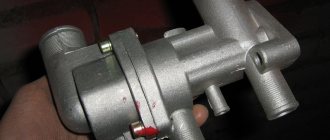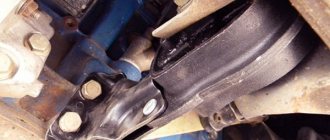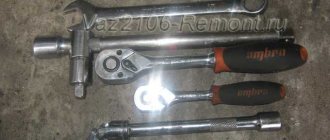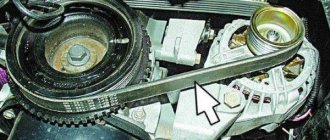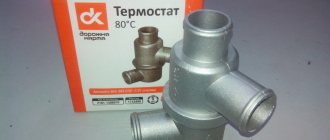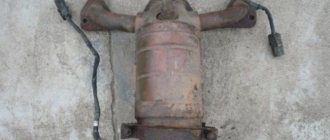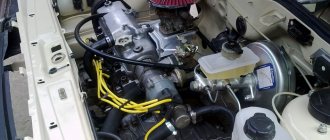Purpose of the device
Thermostat for VAZ-2114 car
Essentially, a thermostat is a large valve whose task is to allow (or, conversely, not to allow) coolant into the car radiator .
When the car's engine has just started, it remains cold for some time, as does the coolant. During this period of time, the thermostat valve is closed, so that the coolant is directed in the so-called small circle. And when the engine temperature reaches 90°C, the valve in the device automatically opens and the coolant begins to circulate in a large circle and enters the radiator. Thanks to this operating scheme, the engine temperature is kept at a constant level, and overheating is eliminated.
Tips before starting the procedure
- Before you begin removing the thermostat on a VAZ 2112, be sure to ensure that it has completely cooled down after operation.
- The thermostat is removed when it is replaced due to unstable engine temperature conditions (overheating, insufficient heating). To carry out this procedure, completely draining the coolant is not necessary.
- To check the condition of the thermostat, start the car engine and touch the lower radiator hose, at first it should remain cold, and only after the coolant temperature reaches about 90 degrees, the hose will begin to gradually heat up. If there is no such reaction to the manipulations performed, remove the thermostat from the car and check its functionality; if defects are detected, it must be replaced with a new one.
This is interesting: Camry 40 fuse blocks: where, how to decipher, diagram
Reasons for replacement
As mentioned above, the thermostat is a valve, and therefore it can get stuck open, closed, or in between. This is the main reason for replacing thermostats on the VAZ-2114, and each case of jamming of the device is dangerous in its own way.
- If the thermostat valve is stuck in the closed position, this will cause the engine to heat up very quickly (especially when the car is used in the summer), since the coolant will constantly circulate only in a small circle.
- If the valve is open all the time, another problem arises: the engine will take a very long time to warm up to operating temperature. And in thirty-degree frost it will be almost impossible to warm up the engine, since the liquid circulates in a large circle all the time and simply does not have time to warm up to the required temperature.
- If the valve is stuck in an intermediate position, this can lead to engine problems.
Description and operating diagrams for VAZ 2106, 2107, 2109, 2114
In VAZ cars, the cooling system has a number of features. In particular, a special 2-valve thermostat (additional and main) with a solid (wax) filler is mounted in front of the pump.
While the engine has not yet warmed up, most of the coolant will flow in a small circle, that is, covering the system pump, the cooling jacket of the power unit and cylinders, as well as the thermostat.
The liquid then returns to the pump. At the same time, coolant circulates through the jacket of the intake pipe and the mixing chamber in the carburetor.
If the cabin heater valve is open, then the liquid passes through its radiator.
In the case when the engine is not fully warmed up, that is, the coolant temperature has not yet reached the desired level (90
degrees Celsius), the main valve partially opens, the other (bypass or bypass) valve partially closes, and part of the hot liquid goes to the main radiator.
This allows the power unit to warm up faster. As soon as the temperature reaches 90 degrees Celsius, the valve opens completely, allowing all flow to be directed through the radiator.
The main metals from which the thermostat elements are made are copper and brass.
The principle of operation is similar to what was already discussed above.
Troubleshooting
Before changing the thermostat, you need to make sure that it is the one that is faulty. The ways to do this are listed below:
- The engine starts and warms up for 10 minutes. Then the hood of the car opens, and the hand is carefully brought first to the upper and then to the lower radiator pipe. If the thermostat is in order, these pipes will not burn your hand and their temperature will be approximately the same. If the temperature of the pipes differs so much that it can be felt by a simple touch, then the thermostat is faulty.
- The engine starts, after which the hood immediately opens and the hand is brought to the upper radiator pipe. When the thermostat is working properly, this pipe remains cold until the engine reaches operating temperature, that is, about 10-15 minutes (in the warm season). After this time, the pipe heats up very quickly and noticeably. If this does not happen, the thermostat is faulty.
- And finally, the most time-consuming diagnostic method: the device is removed, placed in a container with water and a thermometer, after which the water is heated until the valve in the thermostat clicks. The temperature at which the valve operates is detected and based on it, conclusions are drawn about the operability of the device (in a working thermostat, the valve operates at a temperature of 90-95°C).
Content
Hide
What's inside the thermostat
How does the VAZ-2101-2107 thermostat work?
Malfunctions of the VAZ-2107 thermostat, checking operation
We select a replacement for a faulty VAZ-2107 thermostat
Replacing the thermostat
This article is for those who want to thoroughly understand how the thermostat of the VAZ “classic” works and works, how to determine the malfunctions of this device, select the right spare part and perform a replacement. It is the thermostat that is to blame for the fact that in winter the cabin is cold and the engine takes a long time to warm up. It is also the most common cause of engine overheating.
What's inside the thermostat
The classic thermostat housing was originally made of brass. Then, different factories at different times produced thermostats with housings made of aluminum alloy and steel. During assembly, a block of two assembled valves is placed inside the two halves of the housing. Then it all gets rolled up and becomes inseparable. The valve block is assembled inside the holder. The rod is fixed motionless. The main and bypass valves can move relative to it, overcoming the force of the springs. On the outside, the housing has three pipes for connection to the water pump (pump), engine and radiator.
1. Inlet pipe (from the engine). 2. Bypass valve. 3. Bypass valve spring. 4. Glass. 5. Rubber insert. 6. Outlet pipe. 7. Main valve spring. 8. Main valve seat. 9. Main valve. 10. Holder. 11. Adjusting nut. 12. Piston. 13. Inlet pipe from the radiator. 14. Filler. 15. Clip. D - fluid inlet from the engine. R - fluid inlet from the radiator. H - liquid outlet to the pump (pump).
How does the VAZ-2101-2107 thermostat work?
After starting a cold engine, antifreeze begins to be pumped through the thermostat housing from the engine to the pump, through the upper and middle pipes. The main valve is closed and does not allow fluid into the radiator, and the bypass valve is open. The engine warms up and the coolant temperature rises. Gradually, heat is transferred to a special filler, which, pushing away from a stationary piston, lifts the valves up (as shown in the picture). The filler and piston must be adjusted so that the opening of the main valve begins at a temperature of 81 degrees C with a tolerance of +4 - +5 degrees (note - only a plus!). The liquid begins to circulate through the radiator and cool, but some of it still passes directly to the pump. Next, the valve rises 6 mm and, at the end of the stroke, closes the bypass valve. If it is not closed, the antifreeze will spin in a “small circle” - pump-motor-thermostat-pump, and this will lead to overheating. The liquid pumped through the radiator quickly cools itself and cools the filler in the thermostat. It compresses, the valves move down with a spring, opening the bypass valve and closing the main valve. This process is continuously repeated, maintaining the engine temperature between 87 and 92 degrees. This is how the thermostat of a car that has recently rolled off the production line works. You don’t need any cardboard, but you will only have to insulate the “face” in frosts below 40!
Read, it might come in handy: Installing the ignition on a VAZ 2107: video, instructions
Malfunctions of the VAZ-2107 thermostat, checking operation
Nothing is eternal under the Moon! And the thermostat gets tired over time. The properties of the filler change, the rubber of the valves becomes dull, and the springs lose their elasticity. We notice that the VAZ-2107 takes a long time to warm up, and in cold weather the temperature gauge needle barely reaches the edge of the green sector. This malfunction can progress and, over time, the temperature will end up in the middle of the white sector of the scale. You can check the operation of the thermostat without removing it from the engine. This is done like this: start the cold engine and feel the lower pipe near the thermostat with your hand. It should not become warm until the temperature indicator needle reaches a point 3-4 mm from the red zone of the scale. If the heat is felt earlier, the thermostat is not fully operational. The second malfunction is engine overheating due to a stuck thermostat. Here everything looks like this - the engine is hot, but the radiator and its pipes are cold. A thermostat with a stuck valve needs to be replaced urgently. If a malfunction occurs far from civilization, you can pick out the main valve and drive to the repair site. There is no need to remove both valves; the engine will overheat, because the “small circle” is not closed.
We select a replacement for a faulty VAZ-2107 thermostat
Is it worth changing it? If the thermostat is stuck, then it is not discussed, of course, changing it. But if it’s underheating, then it’s worth thinking about. The fact is that today it is very difficult to buy a normal thermostat that meets all the parameters. They all work, they open, but too early, or the spring is weak. And, having installed such a product, we get a coolant temperature of 75-80 degrees. This corresponds to the end of the white sector of the temperature indicator. So, if your thermostat does not heat up within such limits, then you should not change it. The exception is when you know for sure that you bought a quality spare part. When purchasing a thermostat, quality can only be assessed approximately. To do this, we inspect the case, packaging, and markings. The assembly must be neat, the coloring must be even and of high quality. Markings must be present - who the manufacturer is, brand and temperature. “Classic” thermostats are designed for a temperature of 82 degrees - this is the beginning of the valve opening. I came across markings of 80 degrees, 83 degrees. There are rumors that there are 90-degree devices on sale, but I have never seen such devices.
Thermostat with steel housing, painted
Thermostat with aluminum alloy body
After an external inspection, try blowing air into the lower pipe. If air passes through, the valve is leaking, take another copy. At home, before you start replacing, give the purchased device one more check. Place it in a suitable pan, fill it with water and place it on the stove. When the water almost boils, carefully, so as not to get burned, remove the thermostat and try to pour water from the tap into the middle pipe. It should flow freely into the lower pipe. The flowing water will cool the filler, and the valve will close again, and water will flow from the upper pipe. If everything is so, then your thermostat is working properly and can be installed on the car.
Read, it may come in handy: How the exhaust system of the VAZ 2101-2107 works and works, repairs and modifications
Replacing the thermostat
In addition to the thermostat itself, we may need new pipes, clamps, and antifreeze. The total capacity of the VAZ-2107 cooling system is 9.85 liters. It is better to use worm clamps; choose thicker ones. It is better to replace the pipes, since the old ones are already hardened and may leak during installation. The procedure is as follows: 1. Disconnect the terminals and remove the battery. 2. Drain the antifreeze through the radiator and block drain plugs; you can simply remove the lower radiator pipe. Place a basin under the car. 3. Loosen the clamps on the engine, pump and radiator. 4. Remove the thermostat along with the pipes. 5. We install new pipes on the new thermostat and tighten them with clamps. 6. Place the assembled unit in place and tighten the clamps. 7. Close all open plugs and fill in fresh antifreeze. 8. Start and warm up the engine until the thermostat opens, add antifreeze. If there is any air left, we raise the front of the car on a suitable hill and run the engine with the radiator cap open for several minutes at 2000 - 3000 rpm. Usually this is enough. 9. Add antifreeze to the radiator and expansion tank, close the plugs tightly. There are a lot of questions about sealant - do I need to coat the places where the pipes fit? If the pipes are soft and the clamps are good, then sealant is not needed.
Which thermostat to choose
To answer this question, it is important to understand one thing: saving on this device is strictly not recommended. A faulty thermostat leads to engine overheating. And overheating entails a lot of problems, the elimination of which can be very expensive. There are 2 brands of thermostats for the VAZ-2114, proven over the years, the quality of which car owners always speak well of:
- LUZAR (Lugansk Automobile Radiator Plant).
Thermostat for VAZ 2114 from LUZAR - WEEN (Poland).
Polish thermostat from WEEN
It is strongly not recommended to buy Chinese-made thermostats for the VAZ-2114 (in particular, BAUTLER); you should also refrain from purchasing devices from PRAMO (Russia, Vladimir), despite the fact that Polish thermoelements are installed there. Both of these brands, although they work, are not durable.
